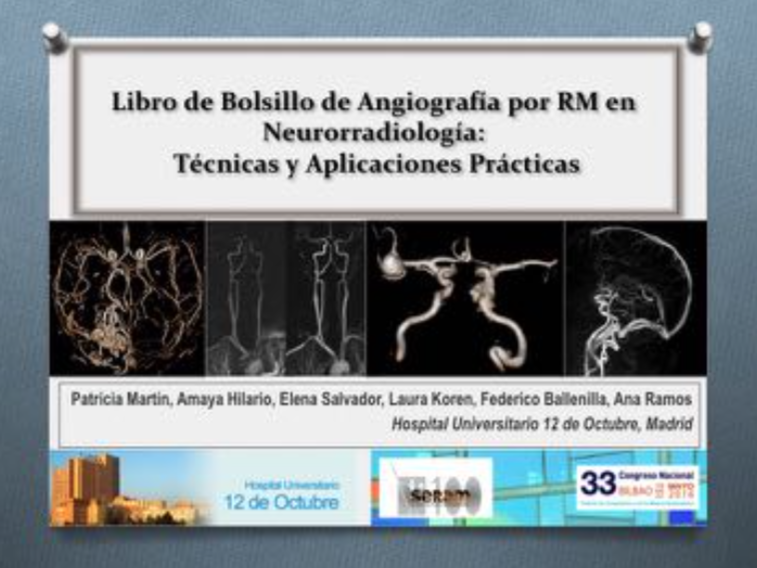LIBRO DE BOLSILLO DE ANGIOGRAFÍA POR RM EN NEURORRADIOLOGÍA:
TÉCNICAS Y APLICACIONES PRÁCTICAS
Palabras clave:
poster, seram, AngiografíaResumen
Objetivos Docentes
• Conocer las técnicas de angiografía por RM (ARM) y sus principios físicos.
• Describir las ventajas, limitaciones y los artefactos de cada técnica.
• Elaborar un algoritmo diagnóstico práctico en función de las principales indicaciones clínicas.
INTRODUCCIÓN:
Los estudios de imagen cerebrovascular se están empleando cada vez con mayor frecuencia en la evaluación de las estructuras arteriovenosas en la región de cabeza y cuello, en el manejo del ictus y en el estudio de cefaleas.
La ARM es una de las técnicas no invasivas más empleadas para el estudio del sistema cerebrovascular.
Descargas
Citas
Pandey S, Hakky M. Application of basics principles of physics to head and neck MR angiography: trouble shooting for artifacts, Radiographics 2013; 33:E113-E123. Published online 10.1148/rg.333125148
Morita S, Masukawa A. Unenhanced MR angiography: techniques and clinical applications in patients with chronic kidney disease. Radiographics 201;31(2):E13-E33.
Ishimaru H et al. Accuracy of pre- and postcontrast 3D time of flight MR angiography in patients with acute ischemic stroke: correlation with catheter angiography. AJNR Am J Neuroradiol 2007;28:923-26.
Richard A. Levy, Jeffrey H. Maki. Three-dimensional contrast-enhanced MR angiography of the extracranial carotid arteries: two techniques. AJNR Am J Neuroradiol 1998;19:688-690.
Leach J, Fortuna R. Imaging of cerebral venous thrombosis: current techniques, spectrum of findings and diagnostic pitfalls. Radiographics 2006;26:S19-S43.
Rolf Jäger H, Moore EA, Grieve JP. Contrast-enhanced MR angiography of intracranial giant aneurysm. AJNR Am J Neuroradiol 2000;21:1900-1907.
Remonda L, Senn P. Contrast-enhanced MR angiography of the carotid artery: comparison with conventional digital subtraction angiography. AJNR Am J Neuroradiol 2002;23:213-219.
Cashen TA, Carr JC. Intracranial time-resolved contrast-enhanced MR angiography at 3T. AJNR Am J Neuroradiol 2006; 27:822-29.
Gauvrit JY, Law M. Time resolved angiography: optimal parallel imagen method. AJNR Am J Neuroradiol 20017;28:835-38.
Sabry A. Elmogy, Jehan A. Mazroa. Non-invasive TOF MR angiographic follow up of coiled cerebral aneurysm. The Egyptian Journal of Radiology and Nuclear Medicine 2012;43:33-40.
Chi-Chang Chen C, Chuen-Tsuei Chang P et al. CT angiography and MR angiography in the evaluation of carotid cavernous sinus fistula prior to embolization: a comparison of techniques. AJNR AM J Neuroradiol 2005;26:2349-2356.
Delgado F, Saiz A, Hilario A et al. Seguimiento mediante técnicas de neuroimagen de los aneurismas cerebrales tratados por vía endovascular. Radiología 2014;56(2):118-128.
Wallace RC, Karis JP. Noninvasive imaging of treated cerebral aneurysms, part I: MR angiographic follow up of coiled aneurysms. AJNR Am J Neuroradiol 2007;28:1001-08.
Cekirge HS, Saatci I. A new aneurysm occlusion classification after the impact of flow modification. AJNR Am J Neuroradiol. Published August 27, 2015. DOI 10.3174/ajnr.A4489.
Lövblad et al. Intracranial aneurysm stenting: follow up with mr angiography. J Magn Reson Imaging 2006;24:418-422.
Idbaih A, Boukobza M. MRI of clot in cerebral venous thrombosis. High diagnostic value of susceptibility-weihgted images. Stroke 2006;37:991-995.
Boukobza M, Crassard I. MR imaging features of isolated cortical vein thrombosis: diagnosis and follow-up. AJNR Am J Neuroradiol 2009;30:344-48.
Elnekeidy AE, Yehia A, Elfatatry A. Importante of susceptibility weighted imaging (SWI) in management of cerebrovascular strokes (CVS). Alexandria Journal of Medicine 2014;50:83-91.
Meckel S, Maier M. MR angiography of dural arteriovenous fistulas: diagnosis and follow up after treatment using a time-resolved 3D contrast-enhanced technique. AJNR Am J Neuroradiol 28;877-84.
Seeger A, Kramer U. Feasibility of non-invasive diagnosis and treatment planning in a case series with carotid-cavernous fistula using high resolution time-resolved MR angiography. Clin Neuroradiol 2015;25(3):241-7.
Farb RI, Agid R. Cranial dural arteriovenous fistula: diagnosis and classification with time resolved angiography at 3T. AJNR Am J Neuroradiol 2009;30:1546-51.
Noguchi K, Kuwayama N. Intracranial dural arteriovenous fistula with retrograde cortical venous drainage: use of susceptibility-weighted imaging in combination with dynamic susceptibility contrast imaging. AJNR Am J Neuroradiol 2010;31:1903-10
Griffiths PD, Hoggard N. Brain arteriovenous malformations: assesment with dynamic MR digital subtraction angiography. AJNR Am J Neuroradiol 2000;21:1892-1899.
Geibprasert S, Pongpech S. Radiologic assesment of brain arteriovenous malformations: what clinicians need to know. Radiographics 2010;30:483-501.
Buis DR, Bot JCJ. The predictive value of 3D time-of-flight MR angiography in assesment of brain arteriovenous malformation obliteration after radiosurgery. AJNR Am J Neuroradiol 2012;33:232-38.
Hadizadeh DR, Kukuk GM. Noninvasive evaluation of cerebral arteriovenous malformations by 4D-MRA for preoperative planning and postoperative follou up in 56 patients: comparison with DSA and intraoperative findings. AJNR Am J Neuroradiol 2012;33:1095-101.
Golay X, Brown SJ. Time-resolved contrast-enhanced carotid MR angiography using sensitivity encoding (SENSE). AJNR Am J Neuroradiol 2001;22:1615-1619.
Rodallec M, Marteau V. Craniocervical arterial dissection: spectrum of imaging findings and differential diagnosis. Radiographics 2008;28:1711-1728.


